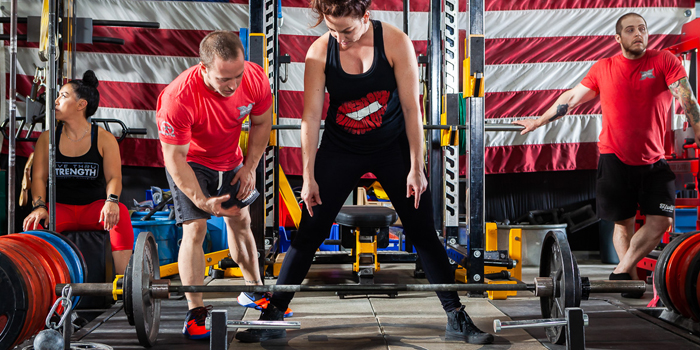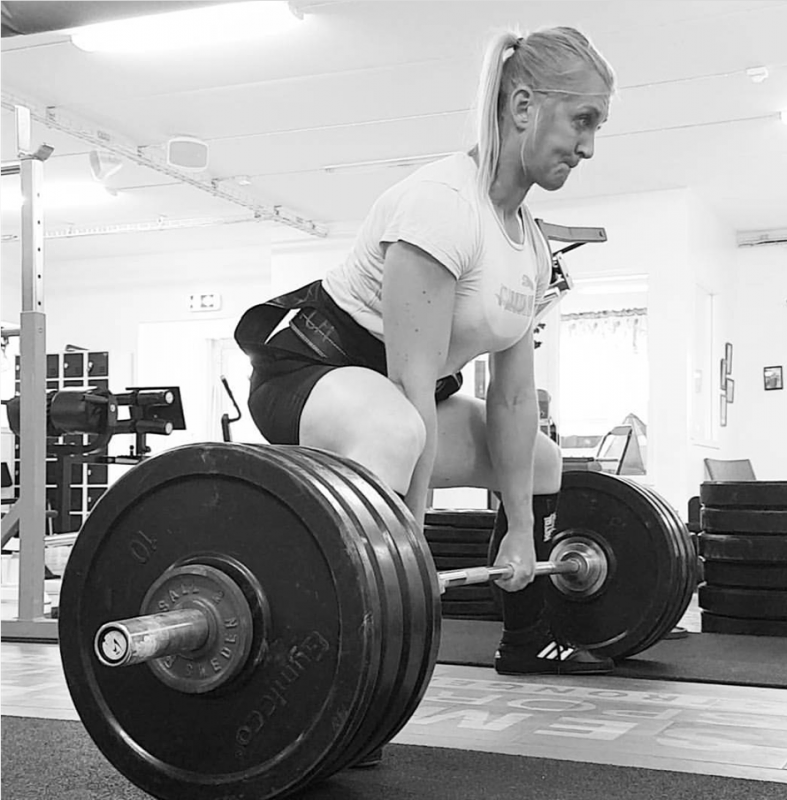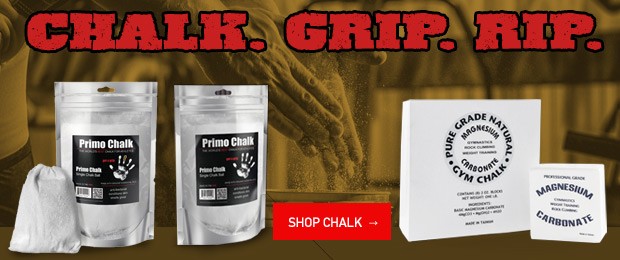
Often people who are performing other sports are advised to do some deadlifts to increase their maximum strength so as to get faster, prevent injuries, etc. But what kind of deadlift should you perform to get the crossover results into your sport? Well, in most sports, you have to move forward with or without weights. Therefore, I think sumo deadlifts are preferred compared with conventional deadlifts. That’s because you work more from the hips, abs, and glutes in the sumo deadlift and not that much with your lower back and quadriceps as you do in the conventional deadlift. Your lower back and quadriceps help you to slow down while running, by straightening your body.
Glutes, abs, and hips, on the other hand, will keep you going (as long as you lean forward). The runners used to say that you should run after your hip. Well, the body is constructed in such a way that you have to spread your legs to move! I trained an athlete who was going to compete in the Arnold Strongman amateur event. One event that he was about to face was the yoke, where he had to run with 420 kilograms/925 pounds. Of course, he couldn’t train with that much weight all of the time, and he needed to train so damn much to get into shape for this competition. He needed to become stronger to run faster. During some sessions, we cut the weight in half for the yoke, and instead, I held a flexband around his hip and walked behind him. This trick was to get him to push forward more with his hip to run faster, and it worked! Well, he didn’t just walk faster with the yoke on the competition day, he ran with it!

That’s why I’m coming back to the idea that you should have a wide stance when you do your deadlifts if your purpose with those lifts is to move faster. Do you get it? Good! So, how should you perform a good sumo deadlift?
- Stand with your feet wider than your shoulders, toes pointing out. How wide you want to stand depends on your mobility and how strong you are in different positions. It’s a very common mistake that people who are trying the sumo deadlift for the first time want to stand as wide as possible. Don’t make that mistake. Find the position that is wide but still a position you feel comfortable with.
- Inhale, and set up your abdominal pressure (read Abdominal Pressure—What You're Missing in Every Lift). Tense all muscles while standing. You should feel like nothing could make you move from the floor.
- Get down to the bar with one hand, keep the pressure, and grab the bar with your other hand. Make sure that you’re using an overhand grip (a mixed grip can twist your posture in the upper back). If you have to use straps, use only one. That’s enough to lock the bar from rotate.
- Press your hip into the bar; you should feel like your groin is about to tear.
- Before your groin tears, press your heels down and keep the pressure in every muscle all of the time.
- When you cross your knees with the bar, push your crotch forward by squeezing your butt, and use your ab pressure. You might be surprised by the fact that your lower back doesn’t need to pull the weight!
- Lean slightly back, imagining that you are hanging in the bar. The bar is the only thing that stops you from falling backward. This will allow you to use gravity to get control of the bar. It’s the same thing as if you were to tear a bush with its roots from the ground. You would be stupid if you tried to tear the bush in a straight line from the ground. Of course, you would hang in the bush and use gravity to put more force on the movement.
Now when you know how to do a proper deadlift for other sports, you might wonder how you should cycle it with your other training. I think the best way to do it is to put sumo deadlifts together with your squats and underbody if you split your upper body and lower body in your program. If you split your muscle groups more like a bodybuilder would, the sumo deadlift should be with the other glute exercises.
I think it’s a mistake to see deadlifts in general as a back exercise. Sure, your back muscles have to be tensed to pull a deadlift (read Stay Focused and Watch Your Back). But it’s the hip muscles that push your hip forward to raise your back. It’s mostly the transversus abdominals and glutes that push the hip forward, and in sumo, the adductors and gluteus medius also have a great impact. The closer your stance is, the easier it is to compensate for it with the lower back. Also, if you point your eyes up, you get a curve on your neck, which leads to a curve in your lower back. If you swank, you have your abs stretched and put all of the weight on your lower back.
Make sure that you hold your neck in a neutral position. The spine is reactive, which means that if you move one area, you also move the reactive area. Last but not least, I want to say, "Yes, I know that not everyone is comfortable with pulling sumo deadlifts because we have different anatomical conditions. And if you find it hard to get a wide sumo position, try a closer one! You don’t need to stand with your toes as wide as possible. You can start to stand just outside of your regular conventional deadlift and successively train to get a little wider as long as it feels okay for you."
Recap
- A stronger sumo deadlift will give you stronger abs and hips.
- A stronger sumo deadlift will help you move faster with or without weights.
- Sumo deadlifts will make you a better athlete!











Got a question for you. Wouldn’t the sumo deadlift require more quads than conventional? I consider the sumo much more of a knee hinge than conventional. I’ve always been under the impression that sumo was more quad dominant. Thoughts?
Thanks,
Ethan
You may be right and I have read these studies which show that there is a higher load on the vastus muscles in the quadriceps than in a conventional deadlift. However, I experience that the sumo deadlift is much more hip dominant, hamstrings assist the gluteus and the transverse abdominal muscles to fix and push the hip forward. The quads provides stability and fixes the starting position, but the drive comes from the hip where the hamstrings assist the movement. The study I saw at Medicine & Science in Sports and Exercise was performed on 13 collegiate football players who performed sumo and conventional deadlifts with and without a lifting belt, employing a 12-RM intensity. Variables measured were knee angles and EMG measurements from 16 muscles. Muscle activity were averaged and compared within three 30° knee angle intervals from 90 to 0° during the ascent, and three 30° knee angle intervals from 0 to 90° during the descent. That study can give some clues, but I think it is to poor to make any statesment from.
Stay strong! / Stefan Waltersson